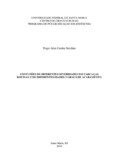| dc.creator | Nardino, Tiago Alan Cunha | |
| dc.date.accessioned | 2019-10-21T15:54:14Z | |
| dc.date.available | 2019-10-21T15:54:14Z | |
| dc.date.issued | 2019-03-15 | |
| dc.identifier.uri | http://repositorio.ufsm.br/handle/1/18633 | |
| dc.description.abstract | The objective of this study was to evaluate the occurrence of bruises in different cuts of bovine carcasses within the different finishing classifications and different ages evaluated by the animal dentition at slaughter. A total of 225,287 carcasses of slaughtered beef cattle were harvested during the years 2014 and 2015. The bruises were classified into 6 classes (hind, hip, loin, ribs, front and innumerous) and two severities (medium and severe) evaluated at 5 degrees of finishes (1,2,3,4,5) and later in 5 ages (milk teeth, 2 teeth, 4 teeth, 5 teeth, 6 teeth). The data were analyzed in statistical software SAS Univerity Edition. The results showed that the mean severity contusions are more frequent than the severe contusions, regardless of the carcass finishing of the animals. The hindquarters and the hip are the sites with the highest occurrence of carcass bruises. Because they are the most frequent carcasses in the line of slaughter, the animals with medium finish are the most representative carcasses among those injured. There is a relationship between the age of the animal and the incidence of medium or severe bruises, and the frequency of these increases with the advancement of the age of the animals. It was also concluded that both medium and severe injuries occur more frequently in the hip, followed by the rear, indicating that the origin of these problems are more related to the facilities and roads than to maltreatment by people who handle the animals for boarding, landing and driving for numbness. | eng |
| dc.language | por | por |
| dc.publisher | Universidade Federal de Santa Maria | por |
| dc.rights | Attribution-NonCommercial-NoDerivatives 4.0 International | * |
| dc.rights.uri | http://creativecommons.org/licenses/by-nc-nd/4.0/ | * |
| dc.subject | Bem-estar animal | por |
| dc.subject | Bovinos de corte | por |
| dc.subject | Lesões na carcaça | por |
| dc.subject | Animal welfare | eng |
| dc.subject | Cattle cut | eng |
| dc.subject | Injuries to the carcass | eng |
| dc.title | Contusões de diferentes severidades em carcaças bovinas com diferentes idades e graus de acabamento | por |
| dc.title.alternative | Different bruises severities in bovine carcass with different ages and dressing of degrees | eng |
| dc.type | Tese | por |
| dc.description.resumo | Este trabalho teve como objetivo avaliar a ocorrência de lesões em diferentes cortes das carcaças de bovinos dentro das diferentes classificações de acabamento e diferentes idades avaliadas pela dentição do animal ao abate. Foram estudadas 225.287 carcaças de bovinos de corte abatidas durante os anos de 2014 e 2015. As lesões foram classificadas em 6 classes (traseiro, quadril, lombo, costilhar, dianteiro e inúmeras) e duas severidades (médio e grave), avaliadas em 5 graus de acabamentos (1,2,3,4,5) e posteriormente em 5 idades (dente de leite, 2 dentes, 4 dentes, 5 dentes, 6 dentes). Os dados foram analisados em software estatístico SAS Univerity Edition. Os resultados obtidos mostraram que as contusões de severidade média são mais frequentes que as contusões graves, independente do acabamento de carcaça dos animais. O traseiro e o quadril são os locais com maior ocorrência de lesões nas carcaças. Por serem as carcaças mais frequentes na linha de abate, os animais com acabamento mediano são as carcaças mais representativas entre aquelas lesionadas. Existe relação entre idade do animal e incidência de contusões médias ou graves, sendo que a frequência destas aumenta com o avanço da idade dos animais. Também se concluiu que tanto as contusões médias como as graves ocorrem com mais frequência no quadril, seguidas pelo traseiro, indicando que a origem desses problemas está mais relacionado às instalações e estradas do que propriamente de maus tratos pelas pessoas que manejam os animais para o embarque, desembarque e condução para a insensibilização. | por |
| dc.contributor.advisor1 | Pacheco, Paulo Santana | |
| dc.contributor.advisor1Lattes | http://lattes.cnpq.br/9700645244479913 | por |
| dc.contributor.referee1 | Vaz, Fabiano Nunes | |
| dc.contributor.referee1Lattes | http://lattes.cnpq.br/3120369205898923 | por |
| dc.contributor.referee2 | Vaz, Ricardo Zambarda | |
| dc.contributor.referee2Lattes | http://lattes.cnpq.br/1120109274579134 | por |
| dc.contributor.referee3 | Fontoura Júnior, José Acélio Silveira da | |
| dc.contributor.referee3Lattes | http://lattes.cnpq.br/8200466219691806 | por |
| dc.contributor.referee4 | Stefanello, Flávia Santi | |
| dc.contributor.referee4Lattes | http://lattes.cnpq.br/9186627434140397 | por |
| dc.creator.Lattes | http://lattes.cnpq.br/9014897407245273 | por |
| dc.publisher.country | Brasil | por |
| dc.publisher.department | Zootecnia | por |
| dc.publisher.initials | UFSM | por |
| dc.publisher.program | Programa de Pós-Graduação em Zootecnia | por |
| dc.subject.cnpq | CNPQ::CIENCIAS AGRARIAS::ZOOTECNIA | por |
| dc.publisher.unidade | Centro de Ciências Rurais | por |



